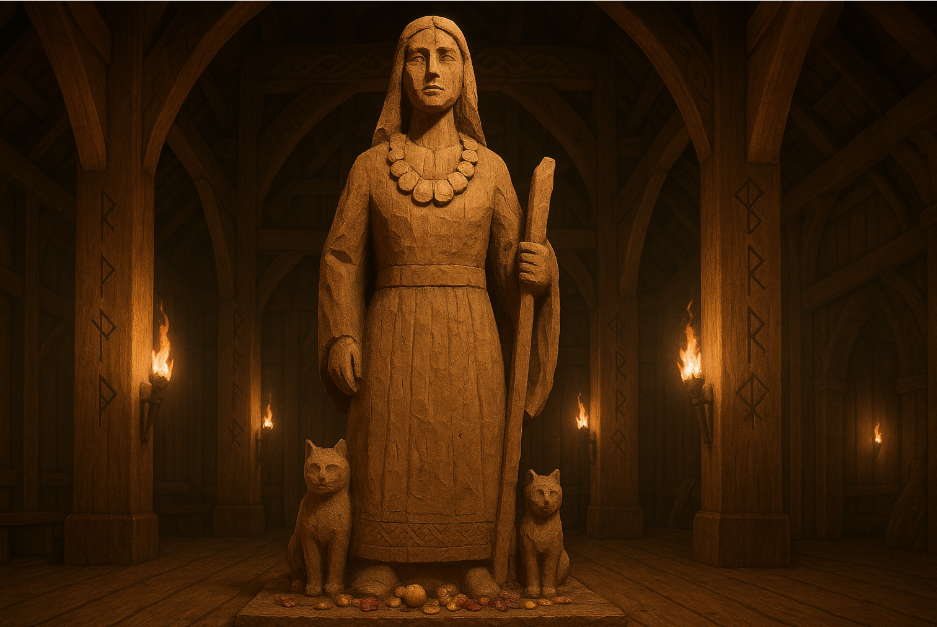
Freya Goddess Statue in the Viking Age
Share
In this article, we dive into the fascinating question: Does an authentic Freya statue exist? Drawing from primary sources, archaeological finds, and scholarly research, we separate fact from modern myth and showcase the real historical evidence behind Freya's sacred imagery. Our commitment to historical accuracy and craftsmanship ensures that when you read or shop with us, you’re connecting with true Norse heritage. At Norse Imports, we are passionate about preserving the authentic history of the Norse world. With years of research into Viking-age archaeology, sagas, and historical records, we have become one of the most trusted sources for accurate Norse education and museum-quality artifact replicas.
The Truth About Freya Goddess Statues: What the Archaeology and Sources Tell Us
When you think of ancient statues of gods, you might picture the towering marble figures of Greek and Roman temples. Unfortunately, when it comes to Norse gods like Freya, things aren't so simple. Many people today ask: Is there an authentic Freya statue? Let's dive into the archaeological evidence, historical records, and what we really know about Freya statues and Viking-age god figures.
Why We Don’t Have Full-Sized Freya Statues
Unlike the Greeks and Romans, the Norse people primarily carved their sacred statues from wood, a material that decays over time. When Christianity swept through Scandinavia around 1000 CE, pagan idols were systematically destroyed. Because of this, no full-sized, life-sized statues of Norse gods(including Freya)have survived.
However, smaller statuettes and pendants from the Viking Age do still exist, and some of these clearly depict Norse gods. In fact, you can find high-quality replicas of many of these artifacts right here in our shop, based directly on the historical finds.




[See our collection of statue museum replicas here]
Archaeological Finds of Norse God Figures
While no large Freya statue has been found, archaeologists have discovered several small figures of Norse gods:
A Thor statuette from Eyrarland, Iceland, showing the thunder god with his hammer.
The Freyr Rällinge statuette from Sweden, representing the god of fertility.
An Odin figurine, complete with one missing eye.
The famous Lejre Odin statue from Denmark, showing the Allfather seated on his high seat Hlidskjalf with ravens and wolves at his side.
A figure believed to depict Tyr, placing his hand into the wolf’s mouth.

The only Freya Goddess Statue found from the Viking age
Yyes—there is one known small amulet that scholars widely agree depicts Freya, identifiable by her famous necklace Brísingamen. This remarkable find is the closest we have to a true Freya statue from the Viking Age.
Goddess Freya Found in Aksa, Sweden

We proudly offer a replica of this Freya amulet in our collection, along with authentic amber necklaces that resemble Brísingamen. [For sale here!]

Written Sources Describing Norse God Statues
Historical texts also confirm that large statues of Norse gods once existed. The most famous account comes from Adam of Bremen (11th century), who describes the temple at Uppsala in Sweden. He wrote about three magnificent statues:
Thor in the center.
Odin (Wotan) on one side.
Freyr (Frikko) on the other side.
These lifesize statues, adorned in gold, were the focus of worship and massive sacrificial rituals. While Freya herself isn't mentioned at Uppsala, the existence of such statues shows that creating god-images was a central part of Norse religion.
Another fascinating find is the Odin from Lejre statuette, discovered in Denmark. Although the nearby written account (by Thietmar of Merseburg) doesn’t specifically mention statues, the discovery supports the idea that temples had carved figures.
Other Norse sagas and historical accounts describe similar scenes:
In the tale Ögmundar þáttr dytts, a large statue of Freyr is paraded from village to village, speaking with a supernatural voice.
In the Saga of Olaf Tryggvason, Christian kings destroy pagan temples and statues, including a statue of Thor at Moere.
In the Saga of Saint Olaf, a giant god statue from Gudbrandsdal is smashed during a dramatic conversion event.
Clearly, statues and idols played a major role in Viking religious life, even if many were destroyed before they could survive to the modern day.
In some sagas, we do see entire temples dedicated to Freyja. it is reasonable to assume that there would have been a statue of her there! It may have looked something like this:

Freya and Brísingamen: The Real Treasure
Although we don’t have a lifesize Freya statue, the Freya amulet with Brísingamen remains a powerful symbol of her legacy. The legendary necklace is described in several Norse myths as a symbol of love, beauty, and fertility—hallmarks of Freya's divine power.
You can explore authentic replicas of the Freya Brísingamen amulet and amber necklaces in our shop, designed to reflect the elegance and sacred symbolism of these original artifacts.
]Baltic Amber Brisingammen Museum Replicas for sale here]

As we continue to learn from archaeology and the old sagas, we gain a deeper appreciation for the ancient devotion to Freya and the rich traditions of the Viking world.
Looking to bring a piece of that history home?
👉 Check out our authentic Freya amulets and Viking jewelry replicas here.
